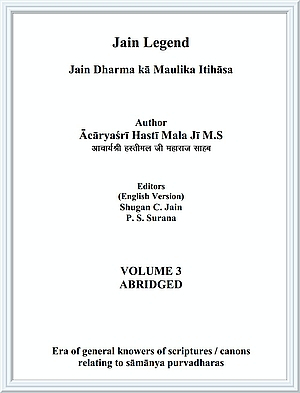Rāṣṭrakūṭa dynasty Mahārājādhirāja Amoghavarṣa-I, other name Nṛpa Tuṃga composed Kavirāja Mārgālaṃkāra in around V.N.1375 and Ratna Mālikā in around V.N.1400.
From citations in these texts, it can be inferred that King Amoghavarṣa-I gave up his rule in V.N.1402 (875AD) and composed Ratna Mālikā while staying in the company of Jain monks and practicing spiritual purification.
King Amoghavarṣa was also a great warrior besides being a great believer and practitioner of Jainism and scholar who composed many texts. Actually in the course of his many victorious wars, in which he was making offensive attacks and also had deep wounds on many parts of his body quit his kingship at his own sweet will and spent his last years of life in the company of Jain monks practicing spiritual purification to prove verbatim the quotation 'je kamme sūrā te dhamme sūrā'.
Śīlāṃkācārya (other name Śīlācārya and Vimala Mati)
Composer of the high level Prākṛata text 'Cauvanna Mahāpurisa cariyaṃ' in V.N. 14th century, Śīlāṃkācārya (other name Śīlācārya and Vimala Mati) was a rising Prākṛata scholar and a great propagator of Jainism.
We find three scholar ācāryas with the same name Śīlāṃkācārya at different times. We find mention of the first Śīlāṃkācārya in Jain literature as a great lexicographer but that lexical text is not available now. The second Śīlāṃkācārya is one who in V.N. 1403 composed Ācārāṃga ṭīkā. This Śīlāṃkācārya wrote ṭīkā on Sūtrakrātaṃga and Jīvasamāsavṛtti also. The third scholar of the same name i.e. Śīlāṃkācārya (other name Śīlācārya and Vimala Mati) composed 'Cauvanna Mahāpurisa cariyaṃ' in V.N.1395. His life sketch is given briefly.
According to 'Prabhāvaka Caritra Ācārya' Sarva in the temple of Koraṃṭaka town addressed Upādhyāya Devacandra of temple dwellers congregation and initiated him in his forest dwellers congregation.
Devacandra after initiation in forest dwellers congregation undertook severe penance Alongwith acquiring deep scriptural knowledge. Impressed by his achievements, Ācārya Sarvadeva anointed Devacandra as ācārya in Varanasi. Since Devacandra had become quite old by this time of his elevation to the post of ācārya, he became popular as Vṛddhadeva.
Pradyotana was the successor of Vṛddhadeva. Influenced by the sermons of Pradyotana, Mānadeva got himself initiated in Śramaṇa monkhood. Staying in close proximity of Pradyotana, Mānadeva acquired deep scriptural knowledge and became an in depth expertise on Jain doctrine. In the end thinking his disciple Mānadeva as fully competent, Pradyotana elevated Mānadeva to the post of ācārya.
While he was a ācārya, he performed severe penance and added to the Jainism's influence. Also as a result of his severe penance, he acquired many extraordinary powers.
Śīlāṃkācārya (other name Śīlācārya and Vimala Mati) was a disciple of this Nivṛtti lineage Mānadeva. This Śīlāṃkācārya (other name Śīlācārya and Vimala Mati) in V.N.925 composed the great text 'Cauvanna Mahāpurisa cariyaṃ' which is a unique jewel of Prākṛata literature.
Śīlāṃkācārya (other name Tattvācārya)
The name of Śīlāṃkācārya; who existed during last half of V.N. 14th century and first half of V.N. 15th century; ranks 71st amongst the expert scholars of scriptures after Devardhigaṇi Kṣamāśramaṇa. He was more famous by his other name Tattvācārya. The author of 'Prabhāvaka Caritra' has given one more name of (other name Tattvācārya) as Koṭyācārya also. You were a scholar par excellence of both Prākṛata and Saṃskṛta. During his time Śīlāṃkācārya was considered as a scholar with authority on scriptures with valid explanations.
With the benevolent feeling of making the monks (male and female) and other inquisitive followers easily grasp the meanings of scriptures and as per the saying 'svāntaḥ sukhāya samaṣṭi hitāya ca'; he used to teach the scriptures by explaining the deep rooted meanings and with multiple meanings of the words therein. As per Ācārya Prabhācandra, "Endowed with such feelings, he composed the ṭīkās on eleven limbs of the scriptures". However only ṭīkās on Ācārāṃga and Sūtrakṛtāṃga are available today and the remaining ṭīkās are not available now. This fact is clearly mentioned in 'Prabhāvaka caritra'. Ācārya Abhayadeva in his ṭīkā on Vyākhyā Prajṅapti has mentioned at several palces the names of the commentators prior to him. This also proves that the ṭīkā on Vyākhyā Prajṅapti by Śīlāṃkācārya was present before Abhayadeva when he was writing the ṭīkā on Vyākhyā Prajṅapti himself. We also do not find mention in literature anywhere of any other ṭīkā on Vyākhyā Prajṅapti except the one by Abhayadeva. This also supports the statement of Ācārya Prabhācandra that Ācārya Śīlāṃka wrote ṭīkās on all the eleven limbs.
Siṃha, the first ācārya of Brahmadvīpikā branch had two disciples namely Madhumitra and Ārya Skandilācārya. Ācārya Gandhahasti, disciple of Ācārya Madhumitra was an influential scholar. He composed mahābhāṣya of 80000 verses on Tattvārthasūtra of Ācārya Umā Swāti. At the request of Ārya Skandilācārya, Ārya Gandhahasti also wrote descriptions on eleven limbs.
While writing the two detailed ṭīkās on Ācārāṃga and Sūtrakṛtāṃga, Ācārya Śīlāṃka the author, did not limit himself just to the meanings of the words in the main text only but also consulted niryuktis and the description on Śastraparijṅā by Gandhahasti etc to make his writings very deep in meaning and touching the roots of the doctrine.
Based on historical facts, it may be completely appropriate to consider Vikram 933 as the time of writing ṭīkās on Ācārāṃga. This is also in line to support the period of 189 years between Śīlāṃka and Abhayadeva and the loss of ṭīkās on other scriptures. Keeping all these facts in mind, we can say that the time of Śīlāṃka is between last half of ninth century Vikram to first half of tenth century.
Śīlāṃka composed the tīkā on Ācārāṃga while living in Gambhūtānagara. He was a ācārya of Nivṛtti lineage. He composed the ṭīkā on Ācārāṃga with the assistance of Vāhari monk. He also wrote the tika on Sūtrakṛtāṃga with the assistance of monk Vāhari.
By composing the ṭīkās on Ācārāṃga and Sūtrakṛtāṃga, Śīlāṃka with deep meanings and explanations, had done a tremendous service to the inquisitives and practitioners of Jainism. These two compositions made Śīlāṃka's name immortal.
 Acharya Hasti Mala
Acharya Hasti Mala
